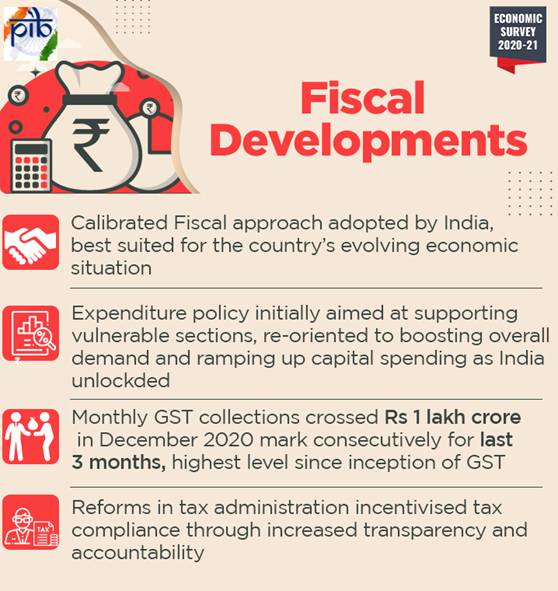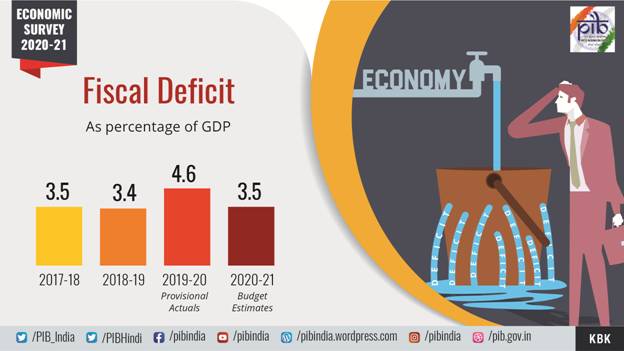Ministry of Finance
Fiscal Policy response in line with Aatma Nirbhar Bharat
Monthly Gross Revenue GST collections Cross 1 Lakh Crore mark for 3 Months in a row
Capital Expenditure for April to December 2020 stands at 3.14 Lakh Crore which is 24% higher than corresponding period of previous year
States allowed to borrow more, beyond their eligibity upto 2% Of GSDP
Posted On:
29 JAN 2021 3:35PM by PIB Delhi
The Economic Survey highlights that fiscal policy response of the Government has been a combination of demand and supply side policies under the ambit of ‘Aatma Nirbhar Bharat’ to cushion against the pandemic shock, and subsequently fuel the economic recovery. The Union Minister for Finance and Corporate Affairs Smt. Nirmala Sitharaman, tabled the Economic Survey 2020-21 in the Parliament today. The Survey observes that “The fiscal policy response of the Government of India to the pandemic was distinct from other countries. Unlike many other countries that chose a front-loaded grand stimulus package for revival of the economy, Government of India adopted a step-by-step approach.”
The Economic Survey highlights that the Government carried out world’s largest food programme, direct transfers to Jan Dhan accounts, government guarantees for credit, etc.The focus of the fiscal stimulus was widened to boost the domestic demand such as ramping up of capital expenditure, Production Linked Incentives and other schemes to revive consumption demand.

Central Government Finances
The Pre Budget survey notes that “the Fiscal Deficit for 2019-20 Provisional Actuals stood at 4.6 per cent of GDP, which was 0.8 percentage points higher than the Fiscal Deficit envisaged in 2019-20 RE, and 1.2 percentage points higher than Fiscal deficit in 2018-19.” The effective Revenue Deficit increased by 1 per cent of GDP to reach 2.4 percent of GDP in 2019-20 PA relative to 2018-19.

The Survey states that corporate and personal income tax have come down in 2019-20 PA mainly due to moderation in growth and implementation of structural reforms like corporate tax rate cut. But recovery is evident on the revenue front, as the monthly gross GST collections has crossed the Rs. 1 lakh crore mark consecutively for the last 3 months. Monthly GST revenues for the month of December 2020 stood at Rs. 1.15 lakh crore, after registering a 12 per cent growth in the GST revenues over December 2019. This has been the highest monthly GST collection since the introduction of GST.
The revenue collections upto November 2020 as against the budgeted are illustrated below:
|
|
Budget Estimates(2020-21)
|
Actual realization(November 2020)
|
|
Net Tax Revenue
|
16.36 Lakh crore
|
42.1% BE (6.88 lakh crore)
|
|
Non Tax Revenue
|
3.85 Lakh crore
|
32.3% BE
|
Further as per the Pre Budget survey, the Non-debt Capital receipts have been pegged at Rs.2.3 lakh crore that is 1 per cent of GDP in 2020-21 BE. On the expenditure front, Budget 2020-21 estimated total expenditure at Rs. 30.42 lakh crore, comprising revenue expenditure of Rs.26.3 lakh crore and capital expenditure of Rs. 4.12 lakh. As a percentage of GDP, the anticipated growth of total expenditure in 2020-21 BE over 2019-20 PA is 0.3 per cent of GDP with growth equivalent to 0.15 per cent of GDP each in both Revenue and capital expenditure.
According to the Survey, total Government expenditure during April to November 2020 stood at 62.7 per cent of Budget estimate, compared to 65.3 per cent in April to November 2019.The capital expenditure for April to December 2020 stood at Rs. 3.17 lakh crore, 24 per cent higher than the capital expenditure during the corresponding period in the previous year. The total expenditure also recorded a YoY growth of 11 per cent.
Moreover, Revenue Expenditure, was envisaged to grow at 11.9 per cent in 2020-21 BE over 2019-20 PA. This is a modest growth rate relative to the 17 per cent growth of revenue expenditure in 2019-20 PA over 2018-19. The expenditure on major subsidies which was pegged at 1.0 per cent of GDP in 2020-21 BE, accounted for a moderate growth of 2.1 per cent over 2019-20 PA.
The share of capital expenditure in total expenditure has on an average sustained at a level. It is estimated to increase roughly by a percentage point in 2020-21 BE over 2019-20 PA, says the Economic Survey. The survey also points that Extra Budgetary resources (EBR) of Rs. 1.35 lakh crore during the period from 2016-17 to 2019-20 was raised. It is estimated to further raise EBR of Rs.49,500 crore in 2020-21 BE which is 0.22 per cent of GDP.
Transfer to States
The Economic survey observes that “Due to a decline in the Gross Tax Revenue collections during 2019-20, a moderation in the States’ share in Central taxes is seen in 2019-20 RE relative to 2018-19. The Budget 2020-21 envisaged a rebound in the total transfers to States from 5.7 per cent of GDP in 2019-20 RE to 6 per cent of GDP in 2020-21 BE.”
State Finances
As per the Survey, “the average Gross Fiscal Deficit Budget Estimate for States that presented their budgets before the outbreak of COVID-19 was 2.4 per cent of GSDP, while the average for budgets presented post-lockdown was 4.6 per cent of GSDP”. In order to re-orient the focus of the States’ fiscal policy on capital expenditure, Central Government has announced Scheme for Special Assistance to States for Capital Expenditure during FY 2021. Also, one-time special dispensation was allowed to the States by allowing additional borrowings amounting to Rs. 0.59 crore for year 2019-20 beyond the State’s eligibility. Additional borrowing limit of up to 2 percent of Gross State Domestic Product (GSDP) was allowed to the States, of which 1% was conditional on state level reform implementation.
General Government Finances
The economic survey observes that in the wake of the global pandemic outbreak, the General Government (Centre plus States) is expected to register a fiscal slippage on account of the shortfall in revenue and higher expenditure requirements. This deviation from the path of fiscal consolidation may however be transient as the fiscal indicators may rebound with the recovery in the economy. The calibrated approach adopted by India allows space for maintaining a fiscal impulse the coming year. The growth recovery would facilitate buoyant revenue collections in the medium term, and thereby enable a sustainable fiscal path.
*****
RM/AA
(Release ID: 1693197)